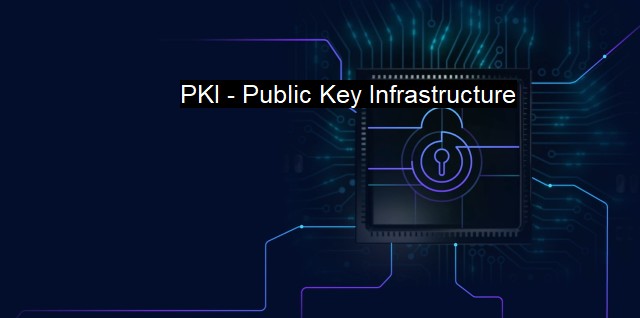What is PKI - Public Key Infrastructure?
The Importance of Public Key Infrastructure (PKI) in Cybersecurity and Antivirus: A Comprehensive Overview
PKI or Public Key Infrastructure is a technology mechanism that utilizes asymmetric cryptography to provide security over digital communications. Originally developed to secure email communication and ecommerce transactions, PKI today is a key technology that is foundational to our digitally connected world. PKI forms the basis for secure confidential electronic communications over insecure public networks, including the internet. PKI's purpose is to provide credentials to the digital identities used to analyse digital transactions.A PKI identifies users and servers during transactions; its roles include the assurance of data integrity, the confidentiality of information, and the authenticity of a transaction. As such, a public key infrastructure carries out the issuance of digital certificates, as well as the revocation of these certificates.
A PKI system serves five major functions — key generation, system registration, certificate deliverance, certificate revocation, and key pair recovery. When properly deployed, PKI provides a robust and scalable platform that can authenticate anyone or anything trying to connect, communicate, and transact on a network — effectively thwarting cybercrime efforts.
PKI stands on the factor of 'trust', conferred by digital certificates, which, similar to a passport, establishes the identity of parties involved in data transactions. These certificates are issued by the trust providers, otherwise known as certificate authorities (CA) — a trusted third party responsible for validating the identity of the certificate holder and its association record of a public key.
The CA verifies the public key's holder's identity before issuing a digital certificate. It follows a strict identification process involving a variety of checks and document verification to ensure that the public key indeed corresponds to the person or entity claimed by the requester. Once a digital certificate is issued, the CA digitally signs it to confirm that the details in the certificate are accurate.
Secure digital communication or transactions are achieved through the secure identification and the encryption of information through public keys included in the digital certificates. In practice, a sender creates a piece of information or a 'message', then encrypts it using the recipient's public key. The recipient then decrypts this information using their private key, ensuring a secure transmission.
Without PKI and encryption, cyber attackers and eavesdroppers could intercept online communication and information. Given the increasing value and amount of personal data stored and transferred digitally, PKI plays an integral role in preventing cyber attacks and securing the cyberspace. This critical role makes PKI a core part of most antivirus and cybersecurity strategies.
By creating, managing, and retiring public-private key pairs and their related certificates, a PKI can help antivirus software verify the integrity and source of software updates. Antivirus software leverages the PKI to ensure that the updates it receives are indeed from the software's creator, thereby reducing the risk of fake updates from malicious actors.
Given how ubiquitous its use is - whether it is securing email communication, verifying the SSL/TLS certificates of websites visited, signing software executables for tamper-proof delivery, or underpinning trust in blockchain transactions - mastery of PKI is paramount for any cybersecurity professional. Through its robust support for confidentiality, integrity, authentication and non-repudiation, PKI forms a cornerstone of any protective measures to ensure the cybersecurity of a digital platform.
Versatility, scale, and adoption are key strengths of PKI as a cybersecurity infrastructure. Cybersecurity professionals continuously harness its potential to create a secure environment. like any technological instrument, the strength of PKI lies in strict and correct implementation.
In a modern age defined by increasing digital interactions, the significance of the security and assurance provided by Public Key Infrastructure cannot be overstated. The ever-increasing dependence on digitisation means that the relevance and application of PKI as a key cybersecurity measure will continue to grow in leaps and bounds. PKI truly forms the backbone of identity management and transactional security, making our digital world fundamentally more secure and reliable.

PKI - Public Key Infrastructure FAQs
What is a PKI?
A PKI or Public Key Infrastructure is a system that is used in cybersecurity to manage and distribute public keys, digital certificates and other cryptographic services.What is the role of PKI in cybersecurity?
PKI plays a key role in cybersecurity as it provides a secure way to authenticate users, encrypt and decrypt data, and ensure the integrity of digital communication. It helps to prevent unauthorized access, data tampering, and other cyber threats.What are the components of PKI?
The main components of a PKI are a certificate authority (CA), registration authority (RA), certificate database, and certificate revocation list (CRL). The CA issues digital certificates, the RA verifies the identity of the certificate applicant, the certificate database stores certificate information, and the CRL maintains a list of revoked certificates.How does PKI work with antivirus software?
PKI and antivirus software work together to protect against cyber threats. PKI provides secure communication between devices and antivirus software detects and removes malware from the system. PKI can also be used to verify the integrity and authenticity of antivirus software updates, ensuring that they are not compromised by hackers.| | A | | | B | | | C | | | D | | | E | | | F | | | G | | | H | | | I | | | J | | | K | | | L | | | M | |
| | N | | | O | | | P | | | Q | | | R | | | S | | | T | | | U | | | V | | | W | | | X | | | Y | | | Z | |
| | 1 | | | 2 | | | 3 | | | 4 | | | 7 | | | 8 | | |||||||